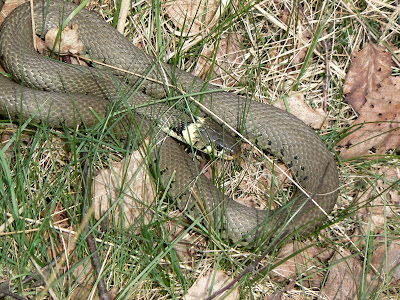With a warm day forecast I headed to the local forest for some reptile study.
The male adders have now all sloughed, so now is the time for mating. I managed to find a female basking early in the morning. Further away were several males also basking.

male with flattened body to maximise warming

another male searching for female

The prize - a large and beautiful female basking under a birch. Note the female characteristics of brown central stripe and lack of black rostral (nose) scale outline. Tail is also less tapered than a male.
Returning later, a male was courting her and defending his prize against all interlopers. Over the next hour he fought off 4 or 5 other males. They appeared to try to rush him almost at once, but he was up to the task, mostly a lunge and fast chase would be enough. Only one male of similar size gave him any trouble and this produced several bouts of the famous 'dance of the adders' where the two males raise half their bodies off the ground in an attempt to push the rival down.

The challenger appears, probably drawn by the females scent

Stand-off. These two males were quite evenly matched. Current top snake on the right

Combat commences.

The victor returns to the female and moves over her in a stange, jerky fashion
The males are so preoccupied that I sat amongst them without disturbance. One male slithered under my legs. It was one of those magical times when, just for a moment, you are accepted into another world.
Common lizards were also about, including what I think was a male judging by the broken vertibral stripe (below). He basked then departed on a short hunting trip.

male? common lizard
































